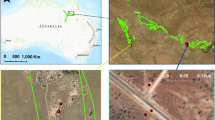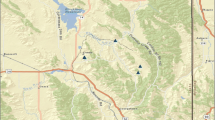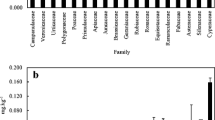Abstract
Vegetation growing in the Ely mining district of White Pine County, NV has been analyzed for tellurium to discover whether Te accumulator plants existed similar to those that take up Se in great quantities. In addition, the variation in Te content among species growing in different geological settings was studied. Another objective of this study was to determine the range of Te concentration in vegetation in regions where the Te content of surface materials was high, as in the Ely mining district, and low as in various areas of western CO. Trees and shrubs (480 samples) as well as flowering plants (505 samples) and their associated edaphic materials were collected from six sites in the Ely region and all plant parts were analyzed for Te, Se, Fe, S, Zn, Cu, and Pb. One hundred and five plants were collected from three areas in western CO.
There is a highly significant difference between Te uptake by trees and that of perennial flowering plants. Flowers contain significantly more Te on the average than other plant parts. An examination of the Te content of tree parts reveals that leaves sorb the most and branches the least. When the Te content of edaphic materials is high, there is a corresponding increase in the Te content of plants. Shallow perennial plants were not found growing in areas where soils contained more than 10 mg kg−1 Te. Seleniferous species ofAstragalus contain larger quantities of Te than plants in the Ely area, whereas nonseleniferous members of this genus contain much less. The nitrotoxin producing Astragali contain concentrations of Te greater than that encountered in nonseleniferous species but less than that in seleniferous ones. No plants contained more than 1 mg kg−1 Te. Iron, Te, Se, and S are coherent in all plants and in most soils and rocks examined.
Similar content being viewed by others
References
G. B. Gott and J. H. McCarthy Jr.,US Geol. Surv. Circ., 535 (1966).
G. B. Gott, J. H. McCarthy Jr., G. H. VanSickle, and J. B. McHugh,US Geol. Surv. Circ., 543 (1967).
O. A. Beath, H. F. Eppson, and C. S. Gilbert,WY Agric. Exp. Sta. Bull., 206 (1935).
C. L. Porter,WY Agric. Exp. Sta. Bull., 491 (1968).
A. E. Hubert,US Geol. Surv. Prof. Pap. 750-D, 162 (1971).
U. M. Cowgill,Biol. Trace Elem. Res. 3, 33 (1981).
J. A. Duke,Econ. Bot. 24, 344 (1970).
I. Rosenfeld and O. Beath,Selenium, Geobotany, Biochemistry, Toxicity and Nutrition, Academic, New York, NY, 1964, p. 312.
J. R. Watterson, G. B. Gott, G. J. Neuerburg, H. W. Lakin, and J. B. Cuthrall,J. Geochem. Explor. 8, 31 (1977).
US Geological Survey, Ruth Quadrangle, White Pine County, Nevada, 7.5 minute series (topographic) (1958).
C. L. Hitchcock and A. Cronquist,Flora of the Pacific Northwest, U. Washington Press, Seattle, WA, 1973.
C. R. Barneby,Atlas of North American Astragalus, Mem. NY Bot. Gard.13, 1 (1964).
W. S. Burbank, T. S. Lovering, E. M. Goddard, and E. B. Eckel, Geologic map of CO, US Geol. Survey (1967).
V. M. Goldschmidt,Geochemistry, Oxford University Press, Oxford, England (1954).
M. C. Williams and R. C. Barneby,Brittonia 29, 310 (1977).
H. J. M. Bowen,Environmental Chemistry of the Elements, Academic, New York, NY (1979).
H. W. Lakin and C. E. Thompson,Science 141, 42 (1963).
H. W. Lakin and C. E. Thompson,US Geol. Surv. Prof. Pap. 450-E, 128 (1963).
A. E. Hubert,US Geol. Surv. Prof. Pap. 750-B, 188 (1971).
J. R. Watterson and G. J. Neuerburg,J. Res. US Geol. Surv. 3, 191 (1975).
T. T. Chao, R. F. Sanzolone, and A. E. Hubert,Anal. Chim. Acta 96, 251 (1978).
U. M. Cowgill,Dev. Appls. Spectrosc. 5, 3 (1966).
K. C. Thompson and D. R. Thomerson,Analyst 99, 595 (1974).
U. M. Cowgill,Appl. Spectrosco. 27, 5 (1973).
A. R. Cooke,Arch. Biochem. Biophys. 55, 114 (1955).
R. R. Sokal and F. J. Rohlf,Biochemistry, Freeman, San Francisco, CA (1969).
Author information
Authors and Affiliations
Rights and permissions
About this article
Cite this article
Cowgill, U.M. The tellurium content of vegetation. Biol Trace Elem Res 17, 43–67 (1988). https://doi.org/10.1007/BF02795446
Received:
Accepted:
Issue Date:
DOI: https://doi.org/10.1007/BF02795446




